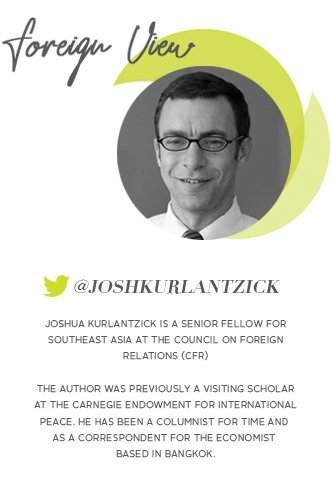
During this Asia trip, the vice president likely will attempt to assuage fears that the White House is disinterested in Asia, and convince Southeast Asian states that the Trump administration’s “Free and Open Indo Pacific” strategy makes sense for Southeast Asian states, and not just for Washington. The concept is designed to link together the Indian and Pacific Oceans in strategic thinking, and also to present a defense of freedom of navigation, sovereignty,, free trade, and free politics in the region.
Southeast Asian states are acutely aware that the region, probably more than any other in the world, has become the center for great power competition between the United States and an increasingly assertive and powerful China. And other than Vietnam, most Southeast Asian countries either remain committed to a strategy of hedging between Beijing and Washington or, for some of the smaller states like Cambodia and Myanmar, have wound up directly in China’s strategic orbit.
Still, in the past two years some Southeast Asian countries have grown increasingly uncomfortable with aspects of China’s regional power. The Mahathir Mohamad administration has canceled several China-backed infrastructure projects, expressed growing concern about Beijing’s South China Sea strategy, and recently defied China’s extradition request by refusing to deport Uighurs to China. How China responds to Mahathir’s actions still remains unclear. Other Southeast Asian states, too, have grown wary of some of Beijing’s strategic and economic strategies. Even in Thailand, the junta, despite close ties to China and the vital China-Thailand trade relationship, has proposed creating a mainland Southeast Asian alternative to China’s Belt and Road Initiative.
Pence is unlikely to convince most Southeast Asian countries to abandon their hedging strategies, but he will probably take several steps to play on the region’s growing concerns about China’s power, to demonstrate that Washington will remain the critical Southeast Asian actor, and that the White House’s Free and Open Indo-Pacific idea can have benefits for Southeast Asia. To be sure, his argument that the United States will remain vital in Southeast Asia, and cares deeply about the region, will be undercut by the fact that he is still the vice president, while the U.S. president decided to skip these major Asian summits for a trip to Europe instead.
Pence probably will give significant time to discussing the White House’s new aid program. The Trump administration, which initially disdained foreign aid, has dramatically reversed course and developed a blueprint for a U.S.-led alternative to China’s Belt and Road Initiative. The U.S.-led project, which will likely be focused on aid for infrastructure as well as other types of developmental assistance, cannot match the overall size of BRI, but the White House has rhetorically committed significant funds to it. The New York Times reported that the administration has launched “the United States International Development Finance Corporation — and gave it authority to provide $60 billion in loans, loan guarantees and insurance to companies willing to do business in developing nations. “ The initiative is part of a dramatic escalation in tensions between Washington and Beijing, on all fronts – strategic, trade, and now aid as well.
The White House also may attempt to rekindle bilateral trade talks in Southeast Asia, although such an effort has been complicated by the Trump administration’s revisions of the North American Free Trade Agreement, now known as the USMCA. Vietnam was one of the countries with which the White House hoped to eventually start bilateral trade talks, but Hanoi – already angered by the Trump administration’s withdrawal from the Trans Pacific Partnership – probably will be even warier of a trade deal with Washington, given that the USMCA has relatively strong labor rights provisions in it. After the NAFTA revision, any U.S. trade deals with Asian states would probably replicate these. (Vietnam still has approved joining the revamped TPP, even without the United States in the deal.)
Still, Pence may try to move the ball forward on exploratory trade talks with Hanoi and Manila, the two likeliest options. The vice president also likely will discuss some kind of trade deal with Tokyo during a November visit to Japan.
Pence also probably will attempt to get Asian states to make clearer rhetorical commitments to U.S. efforts to push back against China’s actions in the South China Sea, such as through proposed plans by the U.S. navy to hold large exercises near China’s claimed territories in the Sea. Although even Southeast Asian states that have launched their own exercises to warn Beijing over territorial claims, like Indonesia, are unlikely to openly endorse such actions, Pence and other U.S. officials will hope that, in private, Southeast Asian leaders will support more assertive actions by the U.S. navy and close partners like Australia.
Some Southeast Asian states may even be willing to echo the United States’ tough rhetoric publicly. As Derek Grossman of the RAND Corporation has noted, Vietnamese officials have, in public statements, sounded much like the Trump administration in talking about the need to unite countries in the Asia-Pacific and defend freedom of navigation. Indeed, Pence is likely to get the warmest reception from Vietnam and Singapore, where the Trump administration has many admirers.

